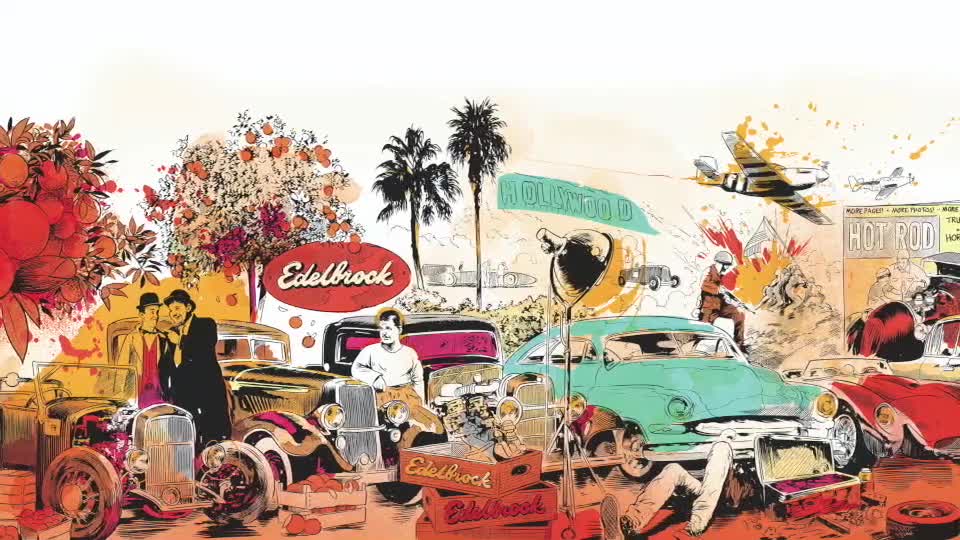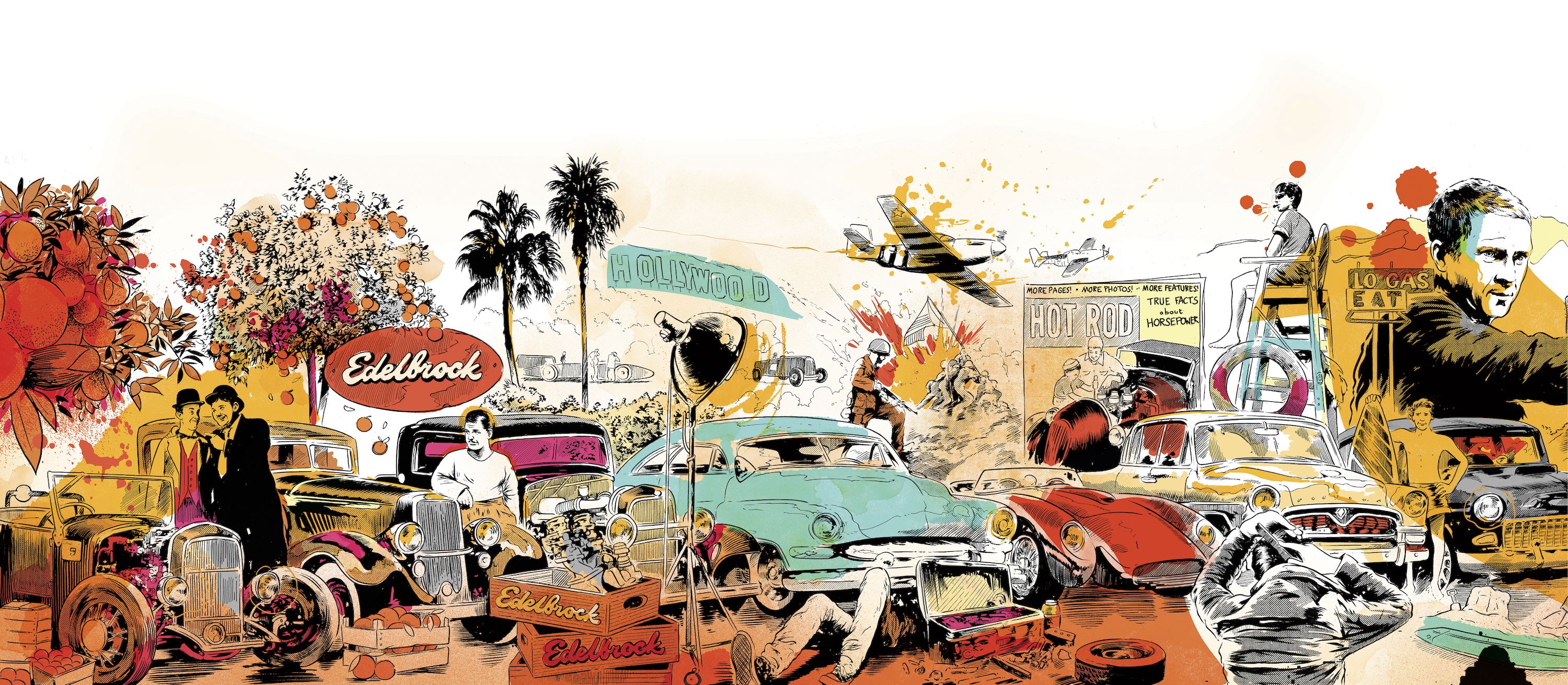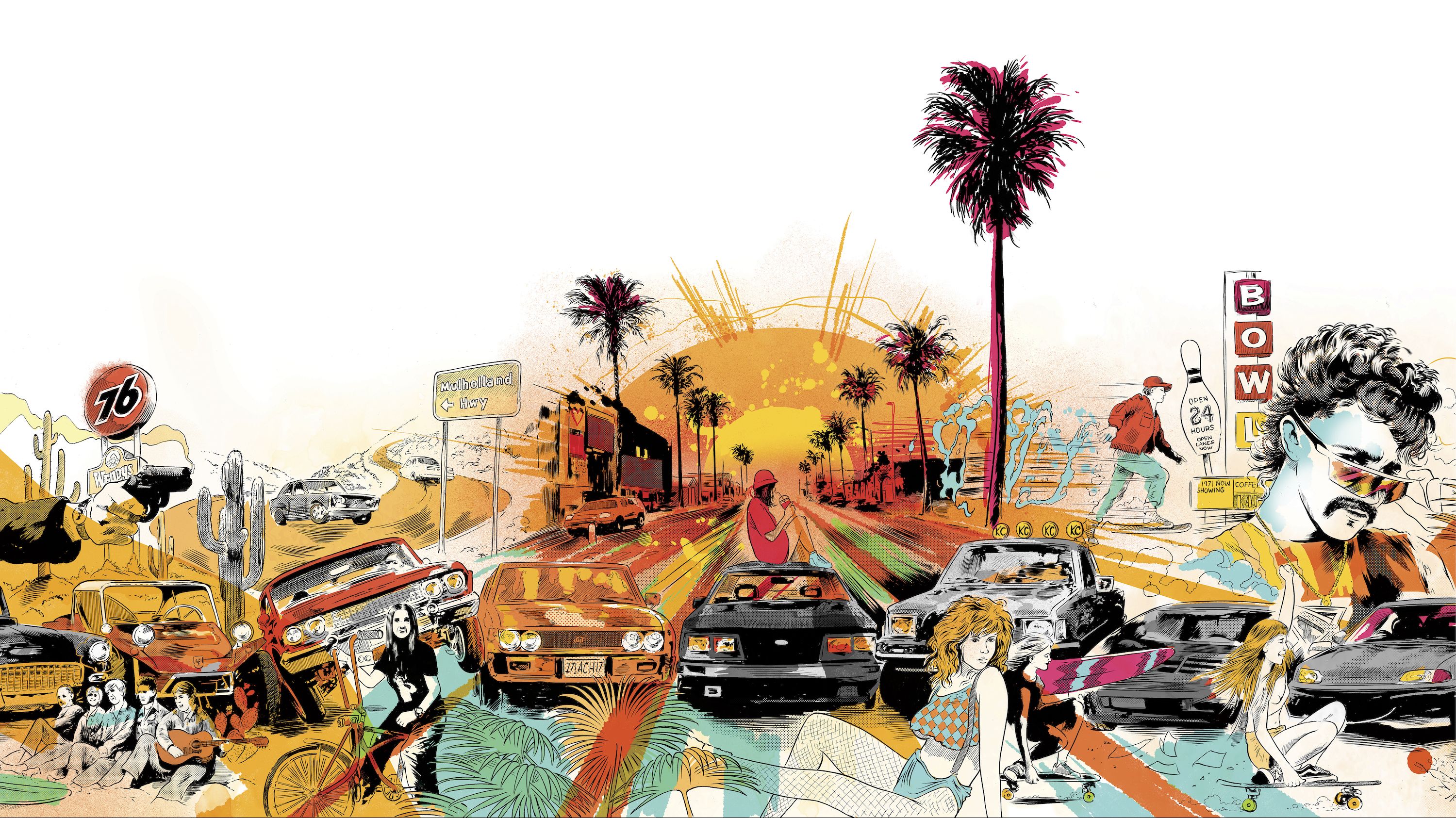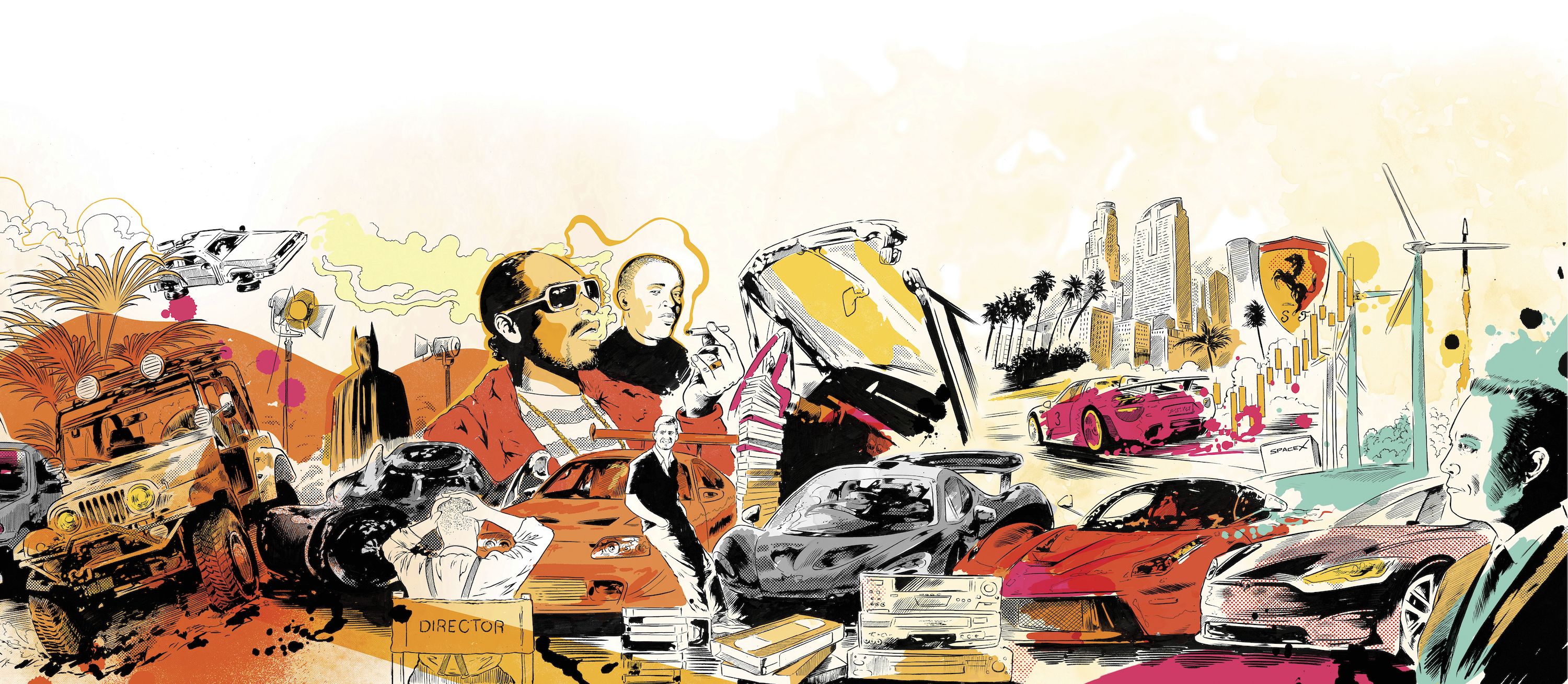Californians drive through clouds of opportunity and enthusiasm. We rushed to the state in the 1840s and ’50s to find gold. We loved the beach and popularized surf culture. We built space rockets, North American P-51s, and Lockheed Electras that were brilliant flyers and way prettier than they had to be. We are home to the world’s salad bowl and the birthplace of that thing called the internet. Music, movies, personal computers, smartphones, personality cults, ranch dressing, left-wing politics, right-wing politics, and houses built on stilts over eroding beaches—innovative Californians are always exploiting opportunities and indulging enthusiasms.
This story originally appeared in Volume 23 of Road & Track.
But the word that matters here is “drive.” No country, state, kingdom, or emirate has more comprehensively centered around the utility of and love for cars, trucks, SUVs, hot rods, dune buggies, ATVs, roadsters, limousines, and the occasional three-wheeler. And we are always fearlessly futzing with anything that already works.
For more than 100 years, California has been where what’s next in cars is baked. The next 100 will probably be the same story. It starts with Ford’s Model T and goes past Tesla’s Model S.
Arriving in 1908, as the movie industry was establishing itself, the Model T put motion into motion pictures. It starred alongside silent comedians from Charlie Chaplin to the Keystone Kops and reached full hilarity being repeatedly destroyed by Laurel and Hardy in the Twenties and Thirties. Meanwhile, on the other side of Los Angeles, George Riley was building the “Multi Lift,” which modified the T’s valves for higher lift and better efficiency. The aftermarket speed industry was born.
The Walter M. Murphy Company opened in Pasadena in 1920 and would produce some of the greatest coachwork ever plopped atop a Duesenberg chassis. Murphy produced true California classics before closing in 1932.
Hot-rodding started with addition through subtraction. Taking the fenders and bumpers off a 1932 Ford dropped weight and produced the Golden State’s superstar, the V-8-powered highboy roadster. In 1937, jalopy fiends formed the Southern California Timing Association, the group that still organizes and sanctions the speed runs on dry lakes such as El Mirage in California and the Bonneville Salt Flats in Utah.
During World War II, aircraft production in California grew exponentially. Fabrication skills learned at Lockheed, North American, or Douglas transferred to the creation of postwar land-speed-record belly tankers, lead sleds like the Hirohata Merc, and dozens of companies to feed the car mania. Robert E. Petersen started Hot Rod magazine in 1947 and organized drag racing and the speed industry around it. In 1951, Wally Parks formed the National Hot Rod Association, and sanctioned drag racing became a thing.
Road & Track moved to Southern California in 1951 as sports-car culture reached a fever pitch in the region. Road racers battled in Palm Springs, airports turned into temporary racetracks, and California dealerships for makes such as Porsche, MG, Jaguar, and Ferrari were practically clubhouses. Santa Monica’s Phil Hill and Riverside’s Dan Gurney became racing legends. In 1957, both Riverside International Raceway in the south and Laguna Seca Raceway in the north opened.
Almost unnoticed, Toyota’s first U.S. dealership, Toyota of Hollywood, also opened in 1957, selling the toylike Toyopet. Honda crossed the Pacific to California as well, establishing its American base in Los Angeles in 1959.
What to do on a hot summer night before air-conditioning or Instagram? Cruising California’s downtowns was the defining ritual of Fifties and early-Sixties teens. And it was Modesto’s George Lucas who later captured the angst and glory of it in American Graffiti.
Carroll Shelby was all Texan, but he built his cars in Southern California, where the aircraft-trained talent and much of the market for his Cobras and GT350s were. Between 1962 and 1967, while his roadgoing Cobras started life in Surrey, England, it was in Los Angeles where they were fortified to become true Shelby brutes.
Meanwhile, in the early Sixties, Bruce Meyers of Fountain Valley lopped the body off a VW, chopped down the chassis, threw on some fiberglass, and created the dune buggy. By 1967, he and other fanatics were invading Baja California (different country, but still California) to run a 1000-mile race across the desert. Off-road racing was born.
In 1968, Mattel, based in Hawthorne, began selling Hot Wheels in blister packs, heralding them as “California Custom Miniatures,” and the greatest movie car chase of all time was staged along the streets of San Francisco for Bullitt. California car culture was a worldwide product.
Lowriding was an established phenomenon in the Seventies and expanded wildly as Latino culture flourished in the state. A few brave souls began building radical Porsches to race across Mulholland Drive on the mountain ridge separating Los Angeles from the San Fernando Valley. Meanwhile, racers such as Menlo Park’s Peter Brock fortified Datsun 510s for SCCA racing.
Toyota opened its Calty Design Research studio in El Segundo in 1973, and the 1978 Celica was the pioneering facility’s first model to reach showroom floors. Practically every other vehicle manufacturer now has a design studio in the state.
By the Eighties, the sheer diversity of California’s love of wheels was exploding. There was rock crawling across the Rubicon Trail, street-racer 5.0-liter Fox-body Mustangs were common, and lowered trucks competed with lifted ones for attention. And San Pedro’s Jerry Wiegert produced the lunacy that was the Vector W8.
California’s sport-compact mania was goofily immortalized with the Fast and the Furious movie franchise beginning in 2001, and the Mark IV Supra Turbo became a cultural totem. Ferrari, knowing its customers loved cruising Rodeo Drive as much as clipping apexes, introduced its second model named California in 2008. And events like Monterey Car Week pushed classic Ferrari and Porsche values ever more skyward.
Always environmentally conscious—Earth Day was created after the 1969 Santa Barbara oil spill—California has led in the creation of the new generation of all-electric vehicles. The first Tesla Roadsters were assembled in 2008 in Menlo Park, and one of the company’s major production facilities is a former GM-Toyota plant in Fremont. The Tesla Model S, first shown in 2009, was designed in California. So were Lucids, Rivians, Fiskers, and others.
Books have been written about California car culture. And many, many more are yet to come, even as California’s various other creations have made books seem obsolete.

John Pearley Huffman has been writing about cars since 1990 and is getting okay at it. Besides Road & Track, his work has appeared in Car and Driver, the New York Times and more than 100 automotive publications and websites. A graduate of UC Santa Barbara, he still lives near that campus with his wife and two children. He owns a pair of Toyota Tundras and two dogs. He used to have a Nova and a Camaro.
Californians drive through clouds of opportunity and enthusiasm. We rushed to the state in the 1840s and ’50s to find gold. We loved the beach and popularized surf culture. We built space rockets, North American P-51s, and Lockheed Electras that were brilliant flyers and way prettier than they had to be. We are home to the world’s salad bowl and the birthplace of that thing called the internet. Music, movies, personal computers, smartphones, personality cults, ranch dressing, left-wing politics, right-wing politics, and houses built on stilts over eroding beaches—innovative Californians are always exploiting opportunities and indulging enthusiasms.
This story originally appeared in Volume 23 of Road & Track.
But the word that matters here is “drive.” No country, state, kingdom, or emirate has more comprehensively centered around the utility of and love for cars, trucks, SUVs, hot rods, dune buggies, ATVs, roadsters, limousines, and the occasional three-wheeler. And we are always fearlessly futzing with anything that already works.
For more than 100 years, California has been where what’s next in cars is baked. The next 100 will probably be the same story. It starts with Ford’s Model T and goes past Tesla’s Model S.
Arriving in 1908, as the movie industry was establishing itself, the Model T put motion into motion pictures. It starred alongside silent comedians from Charlie Chaplin to the Keystone Kops and reached full hilarity being repeatedly destroyed by Laurel and Hardy in the Twenties and Thirties. Meanwhile, on the other side of Los Angeles, George Riley was building the “Multi Lift,” which modified the T’s valves for higher lift and better efficiency. The aftermarket speed industry was born.
The Walter M. Murphy Company opened in Pasadena in 1920 and would produce some of the greatest coachwork ever plopped atop a Duesenberg chassis. Murphy produced true California classics before closing in 1932.
Hot-rodding started with addition through subtraction. Taking the fenders and bumpers off a 1932 Ford dropped weight and produced the Golden State’s superstar, the V-8-powered highboy roadster. In 1937, jalopy fiends formed the Southern California Timing Association, the group that still organizes and sanctions the speed runs on dry lakes such as El Mirage in California and the Bonneville Salt Flats in Utah.
During World War II, aircraft production in California grew exponentially. Fabrication skills learned at Lockheed, North American, or Douglas transferred to the creation of postwar land-speed-record belly tankers, lead sleds like the Hirohata Merc, and dozens of companies to feed the car mania. Robert E. Petersen started Hot Rod magazine in 1947 and organized drag racing and the speed industry around it. In 1951, Wally Parks formed the National Hot Rod Association, and sanctioned drag racing became a thing.
Road & Track moved to Southern California in 1951 as sports-car culture reached a fever pitch in the region. Road racers battled in Palm Springs, airports turned into temporary racetracks, and California dealerships for makes such as Porsche, MG, Jaguar, and Ferrari were practically clubhouses. Santa Monica’s Phil Hill and Riverside’s Dan Gurney became racing legends. In 1957, both Riverside International Raceway in the south and Laguna Seca Raceway in the north opened.
Almost unnoticed, Toyota’s first U.S. dealership, Toyota of Hollywood, also opened in 1957, selling the toylike Toyopet. Honda crossed the Pacific to California as well, establishing its American base in Los Angeles in 1959.
What to do on a hot summer night before air-conditioning or Instagram? Cruising California’s downtowns was the defining ritual of Fifties and early-Sixties teens. And it was Modesto’s George Lucas who later captured the angst and glory of it in American Graffiti.
Carroll Shelby was all Texan, but he built his cars in Southern California, where the aircraft-trained talent and much of the market for his Cobras and GT350s were. Between 1962 and 1967, while his roadgoing Cobras started life in Surrey, England, it was in Los Angeles where they were fortified to become true Shelby brutes.
Meanwhile, in the early Sixties, Bruce Meyers of Fountain Valley lopped the body off a VW, chopped down the chassis, threw on some fiberglass, and created the dune buggy. By 1967, he and other fanatics were invading Baja California (different country, but still California) to run a 1000-mile race across the desert. Off-road racing was born.
In 1968, Mattel, based in Hawthorne, began selling Hot Wheels in blister packs, heralding them as “California Custom Miniatures,” and the greatest movie car chase of all time was staged along the streets of San Francisco for Bullitt. California car culture was a worldwide product.
Lowriding was an established phenomenon in the Seventies and expanded wildly as Latino culture flourished in the state. A few brave souls began building radical Porsches to race across Mulholland Drive on the mountain ridge separating Los Angeles from the San Fernando Valley. Meanwhile, racers such as Menlo Park’s Peter Brock fortified Datsun 510s for SCCA racing.
Toyota opened its Calty Design Research studio in El Segundo in 1973, and the 1978 Celica was the pioneering facility’s first model to reach showroom floors. Practically every other vehicle manufacturer now has a design studio in the state.
By the Eighties, the sheer diversity of California’s love of wheels was exploding. There was rock crawling across the Rubicon Trail, street-racer 5.0-liter Fox-body Mustangs were common, and lowered trucks competed with lifted ones for attention. And San Pedro’s Jerry Wiegert produced the lunacy that was the Vector W8.
California’s sport-compact mania was goofily immortalized with the Fast and the Furious movie franchise beginning in 2001, and the Mark IV Supra Turbo became a cultural totem. Ferrari, knowing its customers loved cruising Rodeo Drive as much as clipping apexes, introduced its second model named California in 2008. And events like Monterey Car Week pushed classic Ferrari and Porsche values ever more skyward.
Always environmentally conscious—Earth Day was created after the 1969 Santa Barbara oil spill—California has led in the creation of the new generation of all-electric vehicles. The first Tesla Roadsters were assembled in 2008 in Menlo Park, and one of the company’s major production facilities is a former GM-Toyota plant in Fremont. The Tesla Model S, first shown in 2009, was designed in California. So were Lucids, Rivians, Fiskers, and others.
Books have been written about California car culture. And many, many more are yet to come, even as California’s various other creations have made books seem obsolete.

John Pearley Huffman has been writing about cars since 1990 and is getting okay at it. Besides Road & Track, his work has appeared in Car and Driver, the New York Times and more than 100 automotive publications and websites. A graduate of UC Santa Barbara, he still lives near that campus with his wife and two children. He owns a pair of Toyota Tundras and two dogs. He used to have a Nova and a Camaro.
Californians drive through clouds of opportunity and enthusiasm. We rushed to the state in the 1840s and ’50s to find gold. We loved the beach and popularized surf culture. We built space rockets, North American P-51s, and Lockheed Electras that were brilliant flyers and way prettier than they had to be. We are home to the world’s salad bowl and the birthplace of that thing called the internet. Music, movies, personal computers, smartphones, personality cults, ranch dressing, left-wing politics, right-wing politics, and houses built on stilts over eroding beaches—innovative Californians are always exploiting opportunities and indulging enthusiasms.
This story originally appeared in Volume 23 of Road & Track.
But the word that matters here is “drive.” No country, state, kingdom, or emirate has more comprehensively centered around the utility of and love for cars, trucks, SUVs, hot rods, dune buggies, ATVs, roadsters, limousines, and the occasional three-wheeler. And we are always fearlessly futzing with anything that already works.
For more than 100 years, California has been where what’s next in cars is baked. The next 100 will probably be the same story. It starts with Ford’s Model T and goes past Tesla’s Model S.
Arriving in 1908, as the movie industry was establishing itself, the Model T put motion into motion pictures. It starred alongside silent comedians from Charlie Chaplin to the Keystone Kops and reached full hilarity being repeatedly destroyed by Laurel and Hardy in the Twenties and Thirties. Meanwhile, on the other side of Los Angeles, George Riley was building the “Multi Lift,” which modified the T’s valves for higher lift and better efficiency. The aftermarket speed industry was born.
The Walter M. Murphy Company opened in Pasadena in 1920 and would produce some of the greatest coachwork ever plopped atop a Duesenberg chassis. Murphy produced true California classics before closing in 1932.
Hot-rodding started with addition through subtraction. Taking the fenders and bumpers off a 1932 Ford dropped weight and produced the Golden State’s superstar, the V-8-powered highboy roadster. In 1937, jalopy fiends formed the Southern California Timing Association, the group that still organizes and sanctions the speed runs on dry lakes such as El Mirage in California and the Bonneville Salt Flats in Utah.
During World War II, aircraft production in California grew exponentially. Fabrication skills learned at Lockheed, North American, or Douglas transferred to the creation of postwar land-speed-record belly tankers, lead sleds like the Hirohata Merc, and dozens of companies to feed the car mania. Robert E. Petersen started Hot Rod magazine in 1947 and organized drag racing and the speed industry around it. In 1951, Wally Parks formed the National Hot Rod Association, and sanctioned drag racing became a thing.
Road & Track moved to Southern California in 1951 as sports-car culture reached a fever pitch in the region. Road racers battled in Palm Springs, airports turned into temporary racetracks, and California dealerships for makes such as Porsche, MG, Jaguar, and Ferrari were practically clubhouses. Santa Monica’s Phil Hill and Riverside’s Dan Gurney became racing legends. In 1957, both Riverside International Raceway in the south and Laguna Seca Raceway in the north opened.
Almost unnoticed, Toyota’s first U.S. dealership, Toyota of Hollywood, also opened in 1957, selling the toylike Toyopet. Honda crossed the Pacific to California as well, establishing its American base in Los Angeles in 1959.
What to do on a hot summer night before air-conditioning or Instagram? Cruising California’s downtowns was the defining ritual of Fifties and early-Sixties teens. And it was Modesto’s George Lucas who later captured the angst and glory of it in American Graffiti.
Carroll Shelby was all Texan, but he built his cars in Southern California, where the aircraft-trained talent and much of the market for his Cobras and GT350s were. Between 1962 and 1967, while his roadgoing Cobras started life in Surrey, England, it was in Los Angeles where they were fortified to become true Shelby brutes.
Meanwhile, in the early Sixties, Bruce Meyers of Fountain Valley lopped the body off a VW, chopped down the chassis, threw on some fiberglass, and created the dune buggy. By 1967, he and other fanatics were invading Baja California (different country, but still California) to run a 1000-mile race across the desert. Off-road racing was born.
In 1968, Mattel, based in Hawthorne, began selling Hot Wheels in blister packs, heralding them as “California Custom Miniatures,” and the greatest movie car chase of all time was staged along the streets of San Francisco for Bullitt. California car culture was a worldwide product.
Lowriding was an established phenomenon in the Seventies and expanded wildly as Latino culture flourished in the state. A few brave souls began building radical Porsches to race across Mulholland Drive on the mountain ridge separating Los Angeles from the San Fernando Valley. Meanwhile, racers such as Menlo Park’s Peter Brock fortified Datsun 510s for SCCA racing.
Toyota opened its Calty Design Research studio in El Segundo in 1973, and the 1978 Celica was the pioneering facility’s first model to reach showroom floors. Practically every other vehicle manufacturer now has a design studio in the state.
By the Eighties, the sheer diversity of California’s love of wheels was exploding. There was rock crawling across the Rubicon Trail, street-racer 5.0-liter Fox-body Mustangs were common, and lowered trucks competed with lifted ones for attention. And San Pedro’s Jerry Wiegert produced the lunacy that was the Vector W8.
California’s sport-compact mania was goofily immortalized with the Fast and the Furious movie franchise beginning in 2001, and the Mark IV Supra Turbo became a cultural totem. Ferrari, knowing its customers loved cruising Rodeo Drive as much as clipping apexes, introduced its second model named California in 2008. And events like Monterey Car Week pushed classic Ferrari and Porsche values ever more skyward.
Always environmentally conscious—Earth Day was created after the 1969 Santa Barbara oil spill—California has led in the creation of the new generation of all-electric vehicles. The first Tesla Roadsters were assembled in 2008 in Menlo Park, and one of the company’s major production facilities is a former GM-Toyota plant in Fremont. The Tesla Model S, first shown in 2009, was designed in California. So were Lucids, Rivians, Fiskers, and others.
Books have been written about California car culture. And many, many more are yet to come, even as California’s various other creations have made books seem obsolete.

John Pearley Huffman has been writing about cars since 1990 and is getting okay at it. Besides Road & Track, his work has appeared in Car and Driver, the New York Times and more than 100 automotive publications and websites. A graduate of UC Santa Barbara, he still lives near that campus with his wife and two children. He owns a pair of Toyota Tundras and two dogs. He used to have a Nova and a Camaro.
Californians drive through clouds of opportunity and enthusiasm. We rushed to the state in the 1840s and ’50s to find gold. We loved the beach and popularized surf culture. We built space rockets, North American P-51s, and Lockheed Electras that were brilliant flyers and way prettier than they had to be. We are home to the world’s salad bowl and the birthplace of that thing called the internet. Music, movies, personal computers, smartphones, personality cults, ranch dressing, left-wing politics, right-wing politics, and houses built on stilts over eroding beaches—innovative Californians are always exploiting opportunities and indulging enthusiasms.
This story originally appeared in Volume 23 of Road & Track.
But the word that matters here is “drive.” No country, state, kingdom, or emirate has more comprehensively centered around the utility of and love for cars, trucks, SUVs, hot rods, dune buggies, ATVs, roadsters, limousines, and the occasional three-wheeler. And we are always fearlessly futzing with anything that already works.
For more than 100 years, California has been where what’s next in cars is baked. The next 100 will probably be the same story. It starts with Ford’s Model T and goes past Tesla’s Model S.
Arriving in 1908, as the movie industry was establishing itself, the Model T put motion into motion pictures. It starred alongside silent comedians from Charlie Chaplin to the Keystone Kops and reached full hilarity being repeatedly destroyed by Laurel and Hardy in the Twenties and Thirties. Meanwhile, on the other side of Los Angeles, George Riley was building the “Multi Lift,” which modified the T’s valves for higher lift and better efficiency. The aftermarket speed industry was born.
The Walter M. Murphy Company opened in Pasadena in 1920 and would produce some of the greatest coachwork ever plopped atop a Duesenberg chassis. Murphy produced true California classics before closing in 1932.
Hot-rodding started with addition through subtraction. Taking the fenders and bumpers off a 1932 Ford dropped weight and produced the Golden State’s superstar, the V-8-powered highboy roadster. In 1937, jalopy fiends formed the Southern California Timing Association, the group that still organizes and sanctions the speed runs on dry lakes such as El Mirage in California and the Bonneville Salt Flats in Utah.
During World War II, aircraft production in California grew exponentially. Fabrication skills learned at Lockheed, North American, or Douglas transferred to the creation of postwar land-speed-record belly tankers, lead sleds like the Hirohata Merc, and dozens of companies to feed the car mania. Robert E. Petersen started Hot Rod magazine in 1947 and organized drag racing and the speed industry around it. In 1951, Wally Parks formed the National Hot Rod Association, and sanctioned drag racing became a thing.
Road & Track moved to Southern California in 1951 as sports-car culture reached a fever pitch in the region. Road racers battled in Palm Springs, airports turned into temporary racetracks, and California dealerships for makes such as Porsche, MG, Jaguar, and Ferrari were practically clubhouses. Santa Monica’s Phil Hill and Riverside’s Dan Gurney became racing legends. In 1957, both Riverside International Raceway in the south and Laguna Seca Raceway in the north opened.
Almost unnoticed, Toyota’s first U.S. dealership, Toyota of Hollywood, also opened in 1957, selling the toylike Toyopet. Honda crossed the Pacific to California as well, establishing its American base in Los Angeles in 1959.
What to do on a hot summer night before air-conditioning or Instagram? Cruising California’s downtowns was the defining ritual of Fifties and early-Sixties teens. And it was Modesto’s George Lucas who later captured the angst and glory of it in American Graffiti.
Carroll Shelby was all Texan, but he built his cars in Southern California, where the aircraft-trained talent and much of the market for his Cobras and GT350s were. Between 1962 and 1967, while his roadgoing Cobras started life in Surrey, England, it was in Los Angeles where they were fortified to become true Shelby brutes.
Meanwhile, in the early Sixties, Bruce Meyers of Fountain Valley lopped the body off a VW, chopped down the chassis, threw on some fiberglass, and created the dune buggy. By 1967, he and other fanatics were invading Baja California (different country, but still California) to run a 1000-mile race across the desert. Off-road racing was born.
In 1968, Mattel, based in Hawthorne, began selling Hot Wheels in blister packs, heralding them as “California Custom Miniatures,” and the greatest movie car chase of all time was staged along the streets of San Francisco for Bullitt. California car culture was a worldwide product.
Lowriding was an established phenomenon in the Seventies and expanded wildly as Latino culture flourished in the state. A few brave souls began building radical Porsches to race across Mulholland Drive on the mountain ridge separating Los Angeles from the San Fernando Valley. Meanwhile, racers such as Menlo Park’s Peter Brock fortified Datsun 510s for SCCA racing.
Toyota opened its Calty Design Research studio in El Segundo in 1973, and the 1978 Celica was the pioneering facility’s first model to reach showroom floors. Practically every other vehicle manufacturer now has a design studio in the state.
By the Eighties, the sheer diversity of California’s love of wheels was exploding. There was rock crawling across the Rubicon Trail, street-racer 5.0-liter Fox-body Mustangs were common, and lowered trucks competed with lifted ones for attention. And San Pedro’s Jerry Wiegert produced the lunacy that was the Vector W8.
California’s sport-compact mania was goofily immortalized with the Fast and the Furious movie franchise beginning in 2001, and the Mark IV Supra Turbo became a cultural totem. Ferrari, knowing its customers loved cruising Rodeo Drive as much as clipping apexes, introduced its second model named California in 2008. And events like Monterey Car Week pushed classic Ferrari and Porsche values ever more skyward.
Always environmentally conscious—Earth Day was created after the 1969 Santa Barbara oil spill—California has led in the creation of the new generation of all-electric vehicles. The first Tesla Roadsters were assembled in 2008 in Menlo Park, and one of the company’s major production facilities is a former GM-Toyota plant in Fremont. The Tesla Model S, first shown in 2009, was designed in California. So were Lucids, Rivians, Fiskers, and others.
Books have been written about California car culture. And many, many more are yet to come, even as California’s various other creations have made books seem obsolete.

John Pearley Huffman has been writing about cars since 1990 and is getting okay at it. Besides Road & Track, his work has appeared in Car and Driver, the New York Times and more than 100 automotive publications and websites. A graduate of UC Santa Barbara, he still lives near that campus with his wife and two children. He owns a pair of Toyota Tundras and two dogs. He used to have a Nova and a Camaro.



















